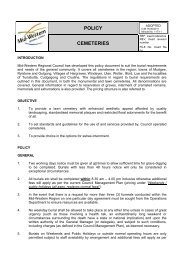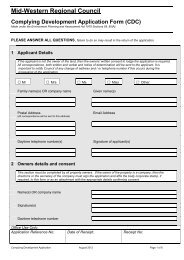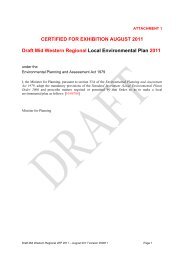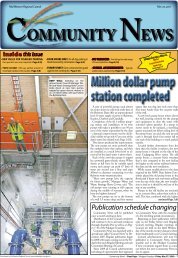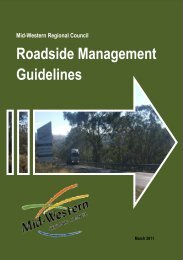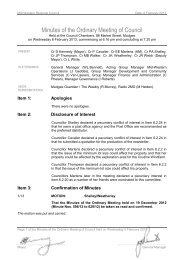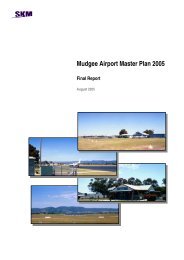preliminary soil salinity assessment - Mid Western Regional Council
preliminary soil salinity assessment - Mid Western Regional Council
preliminary soil salinity assessment - Mid Western Regional Council
Create successful ePaper yourself
Turn your PDF publications into a flip-book with our unique Google optimized e-Paper software.
and mortar in the lower 30cm (approximately) of the exterior walls and one brick was found with alittle crumbling however there was no white marking around this brick.2.5.1 Topography and Surface Water MovementThe land generally slopes down from a small hill on the south western side of the subject area with anorth and north eastern aspect as shown on the topographic map of the general area contained inAppendix B: Current Site Layout, Topography and Soil Pit Locations. The upper slopes are relativelysteeply sloped with the lower slopes more gently sloping down to the virtually flat area of land northof Saleyards Lane. A small embankment runs along the north eastern boundary of Lot 2 in DP534336 the site dropping steeply by approximately 1m down to the alluvial swampy flats adjacent tothe subject land. It appears this embankment has resulted from leveling of the site.The site is dominated by the small hill on the western side of the subject land with limited surfacewater runoff entering the main area of the site from outside. However, a natural watercourse runsalong the eastern side of Lot 399 in DP 1132580 with local drainage flowing north easterly.2.5.2 Soils and Site ConditionErosion was minimal across most of the site however the upper slopes of the hill had very littletop<strong>soil</strong> and sparse vegetation, which is typical of light, gravelly <strong>soil</strong> types after heavy grazing.No significant bare patches, saline scalds or saline seepage areas were visible during the siteinspection. Couch grass (Cynodon dactylon) and kikuyu (Pennisetum clandestinum) were observed inareas across the site. These species are considered to be <strong>salinity</strong> indicator species as they aretolerant of mildly saline conditions.Given that the site was being used for stockpiling roadworks, and on the basis of visual observationsrelating to <strong>soil</strong> <strong>salinity</strong>, for the purpose of a <strong>preliminary</strong> <strong>salinity</strong> <strong>assessment</strong> four (4) sites wereinitially selected within the subject land. These sites were believed to be representative of thedevelopment area and were determined to be areas where <strong>soil</strong> <strong>salinity</strong> may occur due totopography, previous land use and existing water movement within the landscape. Soil pits wereexcavated to approximately 120cm at each of these sites and are identified throughout this report asSites 1 – 4. Further <strong>soil</strong> testing was carried out at sites immediately adjacent to the truck washdownpad (close to the SES building) and immediately next to the remaining leachate pond, once theseareas became accessible and are identified as Site 5 (north of truckwashdown pad, west of SESbuidling) and Site 6 (west of leachate ponds). The locations of the 6 <strong>soil</strong> pit sites were recorded usinga handheld GPS device and are shown on the maps in Appendix B: Current Site Layout, Topographyand Soil Pit Locations. Observations of the <strong>soil</strong> profile were recorded for each pit and <strong>soil</strong> samplingconducted as detailed in Section 2.6 below.The <strong>soil</strong> profiles at the six <strong>soil</strong> pits excavated for use in the field investigation are shown in Plates 1to 6 below. In general, the upper layers of the <strong>soil</strong> profiles (A and B Horizons) across the site aregenerally sandy loams and loams with clay sub<strong>soil</strong>s (C Horizons).Site 1 had grey brown sandy loam top<strong>soil</strong> (A Horizon) down to approximately 15cm. Below this layer,the upper sub<strong>soil</strong> (B Horizon) was a leached, pale grey clay loam that contained dark grey to black,angular gravel less than 20mm diameter appearing in a relatively defined layer. This gravel materialdid not appear to be consistent with the <strong>soil</strong> type and is likely to have been brought in to improvePRELIMINARY SOIL SALINITY ASSESSMENT9



